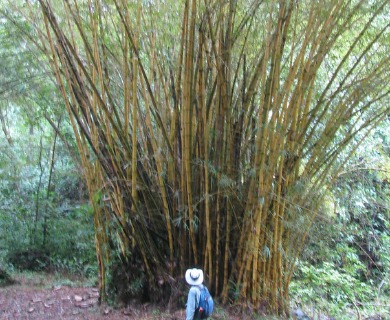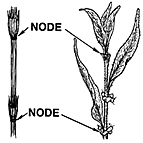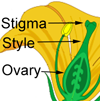Common Bamboo
Bambusa vulgaris
Grass family (Poaceae)
Post-Cook introduction
Bamboos are giant introduced grasses with clustered jointed hollow stems and feathery foliage. In size, they may be classed as trees, though they grow in clumps of several stems, like many shrubs. Their large treelike size and usefulness justify their inclusion here.

©2012 Forest And Kim Starr
It is difficult to distinguish between some of the different species, as the flowers needed for positive identification are rarely produced. However, as a group, bamboos are easily recognized by (1) clusters of several to many slender, tapering, slightly curved stems, in the species of largest size, 2–4 inches (5–10 ) in diameter, dark green to orange, with swollen rings or joints 8–18 inches (20–46 ) apart; (2) several very slender branches spreading horizontally and regularly at the joints; and (3) grass leaves in two rows, consisting of a around the slender twig and long-pointed with many lateral veins parallel to
The stems () attain 30–50 ft (9–15 ) in height and toward the top diverge from the center. The smooth surface, green to dark green, becomes orange or yellow in age. From a distance the plants appear like clumps of giant ferns. The slender side branches about 1⁄4 inch (6 ) in diameter are nearly horizontal and bear wirelike yellow green twigs. Spines are absent in this species.
The light green leaf sheaths are 1 1⁄2–2 1⁄2 inches (4–6 ) long, closely fitting the twig. Blades are 6-10 inches (15–25 ) long and 3⁄4–1 3⁄4 inches (2–4.5 ) wide, or as short as 2 inches (5 ) at base of twig, with rough edges, long-pointed at and short-pointed where narrowed and jointed into The upper surface of the flat thin is green and slightly shiny, the lower surface pale blue green.
Large bamboos bloom only once. After many years, many plants growing together flower simultaneously, produce seeds, and then die. Like most other grasses, bamboos have inconspicuous flowers, usually light brown or straw-colored. The flower cluster () of this species is composed of slender branches bearing bracted clusters of 3–15 or more stalkless spikelets 1⁄2– 3⁄4 inch (13–19 ) long, oblong and pointed, each with several to many flowers () about 3⁄8 inch (10 ) long. The flower has two narrow six with purple protruding and producing an oblong grain.
Not divided into bark and wood, the stem is hollow except at lightweight, hard, and strong. The very hard outer wall is about 1⁄2 inch (13 ) thick, whitish brown, and fibrous.
A new stem completes its height growth from the clustered roots at base in about 3 months, elongating very rapidly, up to 8 inches (20 ) daily. Nor does it expand in diameter after formation.
The young growing at the outside of a clump is readily distinguished by the absence of branches and by the presence at each or joint of a large leaf with by the presence at each or joint of a large leaf with triangular spreading These clasping leaves along the main axis have a very large gray green 6–12 inches (15–30 ) long, extending nearly to the next and bearing many brown needle-like hairs that stick in the flesh when touched, and a short triangular pointed yellow green 2–3 inches (5–7.5 ) long and broad, also with a few brown hairs. Toward the of the elongating stem the leaves are closer together and overlapping.
Bamboos of this and other species have many uses besides ornament. Their masses of intertwining roots and accumulations of leaf litter check erosion on roadside banks and slopes. Poles of various kinds for construction, fences, fence posts, ladders, tool handles, flagpoles, and stakes are easily made from bamboo. The stems will serve as temporary water pipes after opening them on one side at each and removing the partitions. Short pieces are used as pots for seedlings to be transplanted later. Bamboo boards can be prepared by slitting, splitting, and spreading open the stems. The split pieces are woven into baskets. Bamboo stems have been utilized in the manufacture of various articles, including furniture, lattices, fishing rods, picture frames, lampshades, mats, and flower vases. This species is suitable for paper pulp because the stems have relatively long wood fibers.
With outer removed, the tender growing tips of bamboo shoots can be eaten by boiling for about a half hour and changing the water once or twice to remove any bitter taste. There is no distinct flavor except for a slight suggestion of young corn. Bamboo shoots are added to meat stews, salads, and other ways. Young shoots are gathered under stands in the forest by all ethnic groups in Hawaii, even though such use had its origin in China and Japan.
This species of bamboo was introduced into Hawaii probably from China in the early part of the 19th century, according to Hillebrand. He observed that Hawaiians used bamboo for fishing poles and outriggers for canoes. The Hawaiians, however, introduced and used another species, Schizostachyum glaucifolium (Rupr.) Munro. It has thin-walled with long internodes and was used primarily to make musical instruments such as nose flutes. Neal mentioned additional products made by the Hawaiians. Bamboo was used for fans, mats, bellows, straight edges, knives, and pens and stamps for marking tapa bark cloth. Elsewhere, many other uses have been developed, such as construction of houses and manufacture of tools.
Through the Hawaiian Islands, this bamboo is cultivated commonly as an ornamental and soil binder along roadsides and streams and grows as if wild. Bamboo has been planted in large stands in the forest, particularly on Oahu and Maui. A typical stand is near Reservoir No. 3 in Nuuanu Valley on Oahu. Others may be seen from the Hana Road on Maui. Natural vegetative propagation by breaking and rooting of the fragile short branches has been observed elsewhere. However, normal establishment of seedlings is rare because of very infrequent production of seed. The plant is considered by foresters in Hawaii because it takes over and shades out all other vegetation in the wet gulches where it grows best. Fortunately, clones will flower and die periodically, affording an opportunity for other vegetation to recapture the bamboo stands.
Special areas
Waimea Arboretum, Wahiawa
Range
Native of tropical Asia, perhaps India, but widely planted through the tropics. Common in Puerto Rico and Virgin Islands and grown also in southern Florida.
Other common names
feathery bamboo; bamb’u (Puerto Rico, Spanish); pi’ao palao’an (Guam)
Golden bamboo (var. aureo-variegata Beadle) is a handsome ornamental variety characterized by variegated stems with yellow and green vertical stripes.
This is one of the most widely cultivated bamboos in tropical and subtropical regions throughout the world, because of its feathery foliage and large size. It is easily propagated by division of clumps and stem cuttings. This species will endure light frosts but usually is killed to the ground by an infrequent freeze at 28°F (–2°C).





